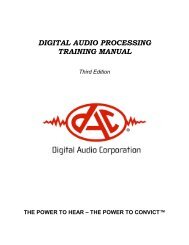QuickEnhance® VST User's Manual - Digital Audio Corporation
QuickEnhance® VST User's Manual - Digital Audio Corporation
QuickEnhance® VST User's Manual - Digital Audio Corporation
You also want an ePaper? Increase the reach of your titles
YUMPU automatically turns print PDFs into web optimized ePapers that Google loves.
Figure 10: Typical Averaged Voice Spectrum<br />
The figure above shows that there is voice information out to 10,000 Hz<br />
and beyond. However, when we expand the upper frequency limit, we<br />
find that the signal usually contains substantially more noise than voice<br />
information. We use the term signal-to-noise ratio, S/N or SNR, to<br />
indicate the relative amount of energy in the desired signal compared<br />
with the interfering noise. The signal-to-noise ratio is defined as:<br />
S / N =<br />
signal energy<br />
noise energy<br />
If we expand the bandwidth, it will only marginally increase the signal<br />
(speech) energy but will substantially increase the noise level. The S/N<br />
ratio decreases as a result, and it is harder to understand the voices. We<br />
want the highest signal-to-noise ratio possible when we are trying to<br />
understand what is being said. We have found that voice quality and<br />
intelligibility are acceptable for a voice frequency band of 200 to 5000 Hz.<br />
Expanding beyond these limits has marginal value.<br />
18
















